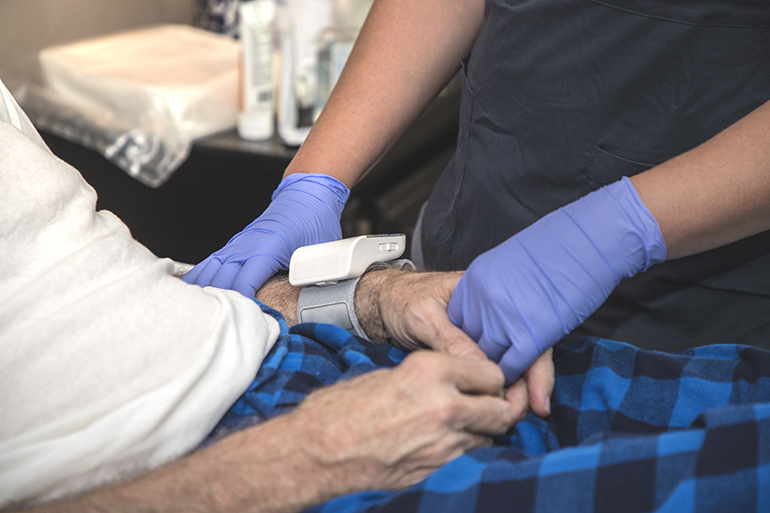A few weeks ago, Kathy Brandt’s 86-year-old mother was hospitalized in Florida after a fall. After rushing to her side, Brandt asked for a consult with a palliative care nurse.
“I wanted someone to make sure my mother was on the right medications,” Brandt said.
For all her expertise — Brandt advises end-of-life organizations across the country — she was taken aback when the nurse suggested hospice care for her mother, who has advanced chronic obstructive pulmonary disease, kidney disease and a rapid, irregular heartbeat.
“I was like — really?” Brandt remembered saying, struggling with shock.
It’s a common reaction. Although hospices now serve more than 1.4 million people a year, this specialized type of care, meant for people with six months or less to live, continues to evoke resistance, fear and misunderstanding.
“The biggest misperception about hospice is that it’s ‘brink-of-death care,’” said Patricia Mehnert, a longtime hospice nurse and interim chief executive officer of TRU Community Care, the first hospice in Colorado.
 NAVIGATING AGING
NAVIGATING AGINGIn fact, hospice care often makes a considerable difference for those with months to live. “When someone is further out from death, we can really focus on enhancing their quality of life,” said Rachel Behrendt, senior vice president of Hospice of the Valley, which serves the Phoenix metropolitan area.
New research confirms that hospice patients report better pain control, more satisfaction with their care and fewer deaths in the hospital or intensive care units than other people with similarly short life expectancies.
What should seniors and their families, the largest users of hospice care, expect? It’s fairly well understood that patients forgo curative therapies in favor of comfort care when they enter hospice. Here are additional features:
Four Levels Of Care
Hospice providers are required to offer routine care in patients’ homes (this includes seniors who reside in assisted living or nursing homes); continuous care at home for people with out-of-control symptoms such as pain or breathing problems; inpatient respite for families that need a break from caring for a loved one; and general inpatient care for medical crises that can’t be handled in any other setting.
With continuous care, a nurse must be on-site in the home for at least eight hours a day, helping to bring symptoms under control. Usually, this will happen in one to three days. Respite care has a maximum limit of five days.
Some hospices have their own general inpatient facilities and “it’s a common misconception that patients are sent to inpatient hospice to die,” said Jean Cohn, clinical manager at Montgomery Hospice’s inpatient facility, Casey House. “In fact, we’re frequently fine-tuning patients’ regimens in inpatient hospice and sending them back home.”
Intermittent Care At Home
Routine care at home is by far the most common service, accounting for about 94 percent of hospice care, according to the latest report from the National Hospice and Palliative Care Organization.
While services vary depending on a patient’s needs, home care typically involves at least one weekly visit from a nurse and a couple of visits from aides for up to 90 minutes. Also, a volunteer may visit, if a patient and family so choose, and social workers and chaplains are available to address practical and spiritual concerns.
Hospices will provide all medications needed to address the underlying illness that is expected to cause the patient’s death, as well as medical equipment such as hospital beds, commodes, wheelchairs, walkers and oxygen. Typically, there is no charge for such gear, although a copay of up to $5 per prescription is allowed.
What families and patients often don’t realize: Hospice staff will not be in the home every day, around the clock. “Many people think that hospice will be there all the time, but it doesn’t work that way,” Brandt said. “The family is still the front line for providing day-to-day care.”
In assisted living, patients or their families may have to hire nursing assistants or companions to provide supplemental care, since hands-on help is limited. In nursing homes, aides may visit less often, since more hands-on help is available on-site.
Self-Referrals Are Allowed
Anyone can ask for a consultation with a hospice. “We get many self-referrals, as well as referrals from family and friends,” said Behrendt of Hospice of the Valley. Usually, a nurse will go out and do a preliminary assessment to determine if a person would qualify for hospice services.
To be admitted, two physicians — the patient’s primary care physician and the hospice physician — need to certify that the person’s life expectancy is six months or less, based on the anticipated trajectory of the patient’s underlying illness. And recertification will be required at regular intervals.
You Choose Your Physician
You have a right to keep your primary care physician or you can choose to have a hospice physician be in charge of your medical care.
At JourneyCare, the largest hospice in Illinois, “we prefer that the patient keeps their primary care physician because that physician knows them best,” said Dr. Mark Grzeskowiak, vice president of medical services.
These arrangements require close collaboration. For instance, if a nurse observes that a patient with heart failure is experiencing increased shortness of breath, JourneyCare staff will get in touch with that patient’s primary care physician. The physician is responsible for altering the treatment plan; the hospice is responsible for implementing that plan and giving clear instructions to the patient and family.
Concerns About Medications
“There’s a misconception that you’re going to be medicated to a highly sedated state in hospice,” said Dr. Christopher Kerr, chief executive officer and chief medical officer for Hospice Buffalo Inc. in upstate New York. “The reality is our primary goal is to increase quality wakefulness. Managing these medications is an art and we’re good at it.”
Family caregivers are on the front line since they’re responsible for administering pain medications such as morphine. “Absolutely, there’s a great deal of fear and anxiety around all the issues associated with giving medications,” said Cohn of Montgomery Hospice. “We try to reassure caregivers that the doses we start with are very small and we’ll see how the patient reacts and go slowly and deliberately from there.”
Because most hospice stays are short — the median length is only 17 days — and because the diversion of painkillers from people’s homes is a risk, doctors have begun writing prescriptions for a week or two at a time, said Judi Lund Person, vice president of regulatory and compliance for the National Hospice and Palliative Care Organization. If concerns exist, hospices can have a lockbox for medications sent to the home.
Discharges Are Possible
Estimating when someone is going to die is an art, not a science, and each year hundreds of thousands of hospice patients end up living longer than doctors anticipated.
If physicians can document continued decline in these patients — for instance, worsening pain or a noticeable advance in their underlying illness — they might be able to recertify them for ongoing hospice care. But if the patient is considered stable, they’ll be discharged, various experts said.
In 2015, nearly 17 percent of hospice patients were so-called live discharges, according to a report from the Medicare Payment Advisory Commission. Two days before a discharge, hospices are required to give the patient or family members a Notice of Medicare Non-Coverage. Expedited appeals of discharge decisions can be lodged with a Medicare quality improvement organization.
There are no regulatory requirements governing what hospices should do to facilitate live discharges. Some hospices will spend weeks helping patients make arrangements to receive medications, medical equipment and ongoing care from other sources. Others offer minimal help.
At The Very End
Almost 1 in 8 hospice patients don’t get visits from professional staff during their last two days of life, according to a study published in JAMA Internal Medicine last year. And this can leave families without needed support.
Some hospices have responded by creating programs specifically for people who have a very short time left to live. “We’ve put together a special team for people who are expected to live 10 days or less because that requires a different kind of management,” said Ann Mitchell, chief executive officer of Montgomery Hospice. “Instead of a nurse for every 15 patients, a nurse on this team will have five to six patients and a social worker is available seven days a week.”
“One-third of our patients are here for less than seven days and often we get them in a crisis,” said Kerr of Hospice Buffalo. “We’ve had to repurpose our services to address the urgency and complexity of these patients’ needs and that means we have to be ever more present.” Across the board, Hospice Buffalo requires that patients be seen within 24 hours of an expected death.
We’re eager to hear from readers about questions you’d like answered, problems you’ve been having with your care and advice you need in dealing with the health care system. Visit kffhealthnews.org/columnists to submit your requests or tips.
KHN’s coverage related to aging & improving care of older adults is supported by The John A. Hartford Foundation and coverage of end-of-life and serious illness issues is supported by The Gordon and Betty Moore Foundation.
KFF Health News' coverage of aging and long-term care issues is supported in part by The SCAN Foundation.







